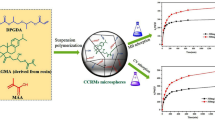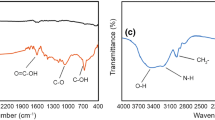Abstract
Organic dyes had caused many environmental problems. It penetrated underground water and caused widespread and long-term pollution. Although many works had been reported, there were still challenges for developing novel technologies of dyes eliminations. In this work, polydopamine/Ag microspheres were synthesized immediately through a convenient synthesis approach in emulsion solutions. Polydopamine microspheres were obtained through the microemulsion method at room temperature. Ag nanoparticles in-situ grew on the surface of modified microspheres. Through the MB solution test, polydopamine/Ag microspheres removed the MB from the solution quickly. Polydopamine/Ag microspheres also eliminated the MB at different temperatures, as well as concentrations and pH values. This method pointed out a new way to develop new materials for dyes elimination.










Similar content being viewed by others
References
Krishnan J, Kishore AA, Suresh A, Madhumeetha B, Prakash DG (2017) Effect of pH, inoculum dose and initial dye concentration on the removal of azo dye mixture under aerobic conditions. Int Biodeterior Biodegradation 119:16–27. https://doi.org/10.1016/j.ibiod.2016.11.024
Amal D, Adel M, Amine K, Abdelkader B, Mohamed S (2019) Alginate-whey an effective and green adsorbent for crystal violet removal: Kinetic, thermodynamic and mechanism studies. Int J Biol Macromol 139(15):944–954. https://doi.org/10.1016/j.ijbiomac.2019.08.068
Amina A, Hassina ZB (2020) Synthesis and characterization of hybrid activated bentonite/alginate composite to improve its effective elimination of dyes stuff from wastewater. Appl Water Sci 10:146. https://doi.org/10.1007/s13201-020-01232-0
Jagannathan K, Anthony AK, Athreya S, Madhumeetha B, Gnana PD (2017) Synchronized methylene blue removal using Fenton-like reaction induced by phosphorous oxoanion and submerged plasma irradiation process. Int Biodeterior Biodegradation 119:16–27. https://doi.org/10.1016/j.ibiod.2016.11.024
Fei W, Swee PY (2021) Using magneto-adsorbent for methylene Blue removal: A decision-making via analytical hierarchy process (AHP). Journal of Water Process Engineering 40:101948. https://doi.org/10.1016/j.jwpe.2021.101948
Vadivelan V, Vasanth KK (2005) Equilibrium, kinetics, mechanism, and process design for the sorption of methylene blue onto rice husk. J Colloid Interface Sci 286(1):90–100. https://doi.org/10.1016/j.jcis.2005.01.007
Yu K, Xiaoping Z, Shaoqi Z (2020) Adsorption of Methylene Blue in Water onto Activated Carbon by Surfactant Modification. Water 12(2):587. https://doi.org/10.3390/w12020587
Mahdi H, Abdolreza S, Hossein SF (2020) Nanoporous composites of activated carbon-metal organic frameworks for organic dye adsorption: Synthesis, adsorption mechanism and kinetics studies. J Ind Eng Chem 81:405–414. https://doi.org/10.1016/j.jiec.2019.09.031
Mustafa TY, Tushar KS, Sharmeen A, Ang HM (2014) Dye and its removal from aqueous solution by adsorption: a review. Adv Colloid Interface Sci 209:172–184. https://doi.org/10.1016/j.cis.2014.04.002
Rohan SD, Sanjit A, Noureddine A (2021) Recent Advances in Biopolymer-Based Dye Removal Technologies. Molecules 26(15):4697. https://doi.org/10.3390/molecules26154697
Ali HJ, Ahmed SA (2020) Statistical modeling of methylene blue dye adsorption by high surface area mesoporous activated carbon from bamboo chip using KOH-assisted thermal activation. Energy, Ecology and Environment 5(6):456–469. https://doi.org/10.1007/s40974-020-00177-z
Zichao L, Lotfi S et al (2020) Adsorption of hazardous dyes on functionalized multiwalled carbon nanotubes in single and binary systems: Experimental study and physicochemical interpretation of the adsorption mechanism. Chem Eng J 389:124467. https://doi.org/10.1016/j.cej.2020.124467
Xiaoxiao L, Ling L, Jie Z, Qinghan M (2021) Capacitive deionization and methyl orange removal of holey graphene hydrogels. Colloids Surf, A 618:126463. https://doi.org/10.1016/j.colsurfa.2021.126463
Luis V, Sugam K, Emma MN, German SA, Aji PM (2020) In-Situ Growth of Metal Oxide Nanoparticles on Cellulose Nanofibrils for Dye Removal and Antimicrobial Applications. ACS Applied Nano Materials 3(7):7172–7181. https://doi.org/10.1021/acsanm.0c01511
Seyyed MTHM, Behrouz E, Vahid J (2020) Biosynthesis of pure zinc oxide nanoparticles using Quince seed mucilage for photocatalytic dye degradation. J Alloy Compd 821:153519. https://doi.org/10.1016/j.jallcom.2019.153519
Khadije B, Vahid J (2021) Enhanced photocatalytic degradation of dye contaminants with TiO2 immobilized on ZSM-5 zeolite modified with nickel nanoparticles. J Clean Prod 280:124518. https://doi.org/10.1016/j.jclepro.2020.124518
Rajkumar B, Madhusudhan A et al (2020) Rapid synchronous synthesis of Ag nanoparticles and Ag nanoparticles/holocellulose nanofibrils: Hg(II) detection and dye discoloration. Carbohydr Polym 240:116356. https://doi.org/10.1016/j.carbpol.2020.116356
Eleni R, Siddharth VP (2020) Degradation of Anthraquinone Dyes from Effluents: A Review Focusing on Enzymatic Dye Degradation with Industrial Potential. Environ Sci Technol 54(2):647–664. https://doi.org/10.1021/acs.est.9b03737
Rui MFB, Mafalda RA, Pankaj B, Mara GF, Ana PMT (2020) Improvements in the enzymatic degradation of textile dyes using ionic-liquid-based surfactants. Separation And Purification Technology 235:116191. https://doi.org/10.1016/j.seppur.2019.116191
Alexsandro JS, Enric B, Pere LC, Ignasi S (2020) Simultaneous persulfate activation by electrogenerated H2O2 and anodic oxidation at a boron-doped diamond anode for the treatment of dye solutions. Sci Total Environ 747:141541. https://doi.org/10.1016/j.scitotenv.2020.141541
Soliu OG, Carlos AMH, Mehmet AO (2021) Electrochemical advanced oxidation processes for wastewater treatment: Advances in formation and detection of reactive species and mechanisms. Curr Opin Electrochem 27:100678. https://doi.org/10.1016/j.coelec.2020.100678
Mao B, An Q, Zhai B et al (2016) Multifunctional hollow polydopamine-based composites (Fe3O4/PDA@Ag) for efficient degradation of organic dyes. RSC Adv 6(53):47761–47770. https://doi.org/10.1039/C6RA05954F
Jingyu L, Jinchao F, Jiaqi L et al (2020) Polydopamine nanotubes decorated with ag nanoparticles as catalyst for the reduction of methylene blue. ACS Applied Nano Materials 3(1):156–164. https://doi.org/10.1021/acsanm.9b01861
Yan-Li J, Wei-Jie Q et al (2019) Mussel-inspired zwitterionic dopamine nanoparticles as building blocks for constructing salt selective nanocomposite membranes. J Membr Sci 572:140–151. https://doi.org/10.1016/j.memsci.2018.11.019
He K, Yan M, Huang Z et al (2019) Fabrication of ploydopamine–kaolin supported Ag nanoparticles as effective catalyst for rapid dye decoloration. Chemosphere 219:400–408. https://doi.org/10.1016/j.chemosphere.2018.12.012
Orishchin N, Crane CC, Brownell M et al (2017) Rapid deposition of uniform polydopamine coatings on nanoparticle surfaces with controllable thickness. Langmuir 33(24):6046–6053. https://doi.org/10.1021/acs.langmuir.7b00671
Cuiru W, Juanjuan Y et al (2019) Facile Preparation of Self-Assembled Polydopamine-Modified Electrospun Fibers for Highly Effective Removal of Organic Dyes. Nanomaterials (Basel) 9(1). https://doi.org/10.3390/nano9010116
Huafeng C, Yi Z, Jianyu W, Jian L, Yanbo Z (2020) Polydopamine modified cyclodextrin polymer as efficient adsorbent for removing cationic dyes and Cu2+. J Hazard Mater 389:121897. https://doi.org/10.1016/j.jhazmat.2019.121897
Dong-Mei G, Qing-Da A, Zuo-Yi X, Shang-Ru Z, Dong-Jiang Y (2018) Efficient removal of Pb(II), Cr(VI) and organic dyes by polydopamine modified chitosan aerogels. Carbohydr Polym 202:306–314. https://doi.org/10.1016/j.carbpol.2018.08.140
Gürbüz MU, Elmacı G, Ertürk AS (2021) In situ deposition of silver nanoparticles on polydopamine-coated manganese ferrite nanoparticles: Synthesis, characterization, and application to the degradation of organic dye pollutants as an efficient magnetically recyclable nanocatalyst. Appl Organomet Chem e6284. https://doi.org/10.1002/aoc.6284
Shun C, Yanyun J, Yi G, Chuanxi X, Lijie D (2017) In-site synthesis of monodisperse, oleylamine-capped Ag nanoparticles through microemulsion approach. J Nanopart Res 19(3):88. https://doi.org/10.1007/s11051-017-3775-0
Acknowledgements
The present work is financially supported by the Innovation Group Fund Project of Hubei Province (No.2020CFA039) and the Key Research and Development Program of Hubei Province (No.2021BCA153).
Author information
Authors and Affiliations
Corresponding author
Ethics declarations
Competing interest
The authors declare that they have no known competing financial interests or personal relationships that could have appeared to influence the work reported in this paper.
Additional information
Publisher's Note
Springer Nature remains neutral with regard to jurisdictional claims in published maps and institutional affiliations.
Rights and permissions
About this article
Cite this article
Chen, S., Xu, H., He, X. et al. One-pot synthesis of polydopamine/Ag microspheres through microemulsion environment and its methylene blue removal application. J Polym Res 29, 34 (2022). https://doi.org/10.1007/s10965-022-02896-9
Received:
Accepted:
Published:
DOI: https://doi.org/10.1007/s10965-022-02896-9




